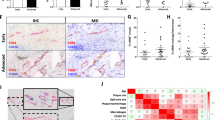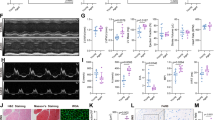Abstract
Background
Cardiovascular diseases are the leading cause of death worldwide, with several conditions being affected by oxidative stress. Ferroptosis, recently identified programmed cell death mechanism, is relies on oxidative stress. This study aimed to determine the expressions of the genes involved in the molecular pathways of oxidative stress and ferroptosis and the association of these genes with CAD risk factors in CAD and non-CAD individuals.
Methods and results
The blood samples of individuals who underwent coronary angiography were collected and divided according to CAD status. Total RNA isolation was performed using the PAXgene RNA isolation kit from the whole blood samples. The mRNA expression levels of RTN3, GPX4, CAT, HMOX1, ELOVL5, SLC25A1, SLC7A11, and ACSL4 genes were determined using Real-Time PCR. Biochemical analyses were done before coronary angiography, and the results were evaluated statistically. The expression levels of the CAT gene are significantly lower in the CAD group when compared to non-CAD. HMOX1 expression levels are positively correlated with stenosis percentage, Gensini, and SYNTAX scores in the CAD group. RTN3, SLC25A1, and GPX4 mRNA expressions are correlated with HDL-C levels. Moreover, HbA1c levels and BMI, correlate negatively with ACSL4 expression in non-CAD controls. Also, ELOVL5 expression is negatively correlated with total bilirubin and direct bilirubin levels in the CAD group.
Conclusions
In this study, the genes related to oxidative stress and ferroptosis were found associated with biochemical parameters associated with CAD risk. These preliminary results may provide a new perspective to further studies investigating the reasons behind the identified associations.





Similar content being viewed by others
Data availability
Our manuscript has no associated data.
References
Libby P, Buring JE, Badimon L, Hansson GK, Deanfield J, Bittencourt MS, Tokgözoğlu L, Lewis EF (2019) Atherosclerosis. Nat Rev Dis Primers 5(1):56. https://doi.org/10.1038/s41572-019-0106-z
Wang H, Liu C, Zhao Y, Gao G (2020) Mitochondria regulation in ferroptosis. Eur J Cell Biol 99(1):151058. https://doi.org/10.1016/j.ejcb.2019.151058
Stockwell BR, Friedmann Angeli JP, Bayir H, Bush AI, Conrad M, Dixon SJ, Fulda S, Gascón S, Hatzios SK, Kagan VE, Noel K, Jiang X, Linkermann A, Murphy ME, Overholtzer M, Oyagi A, Pagnussat GC, Park J, Ran Q, Rosenfeld CS, Salnikow K, Tang D, Torti FM, Torti SV, Toyokuni S, Woerpel KA, Zhang DD (2017) Ferroptosis: a regulated cell death nexus linking metabolism, redox biology, and disease. Cell 171(2):273–285. https://doi.org/10.1016/j.cell.2017.09.021
Guo S, Lu J, Zhuo Y, Xiao M, Xue X, Zhong S, Shen X, Yin C, Li L, Chen Q, Zhu M, Chen B, Zhao M, Zheng L, Tao Y, Yin H (2019) Endogenous cholesterol ester hydroperoxides modulate cholesterol levels and inhibit cholesterol uptake in hepatocytes and macrophages. Redox Biol 21:101069. https://doi.org/10.1016/j.redox.2018.101069
Forrester SJ, Kikuchi DS, Hernandes MS, Xu Q, Griendling KK (2018) Reactive Oxygen Species in Metabolic and Inflammatory Signaling. Circ Res 122(6):877–902. https://doi.org/10.1161/circresaha.117.311401
Tang D, Chen X, Kang R, Kroemer G (2021) Ferroptosis: molecular mechanisms and health implications. Cell Res 31(2):107–125. https://doi.org/10.1038/s41422-020-00441-1
Zheng J, Conrad M (2020) The metabolic underpinnings of ferroptosis. Cell Metab 32(6):920–937. https://doi.org/10.1016/j.cmet.2020.10.011
Xiao L, Luo G, Guo X, Jiang C, Zeng H, Zhou F, Li Y, Yu J (1865) Yao P (2020) Macrophage iron retention aggravates atherosclerosis: Evidence for the role of autocrine formation of hepcidin in plaque macrophages. Biochim Biophys Acta Mol Cell Biol Lipids 2:158531. https://doi.org/10.1016/j.bbalip.2019.158531
Wang Y, Li L, Zhao W, Dou Y, An H, Tao H, Xu X, Jia Y, Lu S, Zhang J, Hu H (2018) Targeted therapy of atherosclerosis by a broad-spectrum reactive oxygen species scavenging nanoparticle with intrinsic anti-inflammatory activity. ACS Nano 12(9):8943–8960. https://doi.org/10.1021/acsnano.8b02037
Guo Z, Ran Q, Roberts LJ 2nd, Zhou L, Richardson A, Sharan C, Wu D, Yang H (2008) Suppression of atherogenesis by overexpression of glutathione peroxidase-4 in apolipoprotein E-deficient mice. Free Radic Biol Med 44(3):343–352. https://doi.org/10.1016/j.freeradbiomed.2007.09.009
Vinchi F, Porto G, Simmelbauer A, Altamura S, Passos ST, Garbowski M, Silva AMN, Spaich S, Seide SE, Sparla R, Hentze MW, Muckenthaler MU (2020) Atherosclerosis is aggravated by iron overload and ameliorated by dietary and pharmacological iron restriction. Eur Heart J 41(28):2681–2695. https://doi.org/10.1093/eurheartj/ehz112
Bai T, Li M, Liu Y, Qiao Z, Wang Z (2020) Inhibition of ferroptosis alleviates atherosclerosis through attenuating lipid peroxidation and endothelial dysfunction in mouse aortic endothelial cell. Free Radic Biol Med 160:92–102. https://doi.org/10.1016/j.freeradbiomed.2020.07.026
Paul SD, Eagle KA, Kuntz KM, Young JR, Hertzer NR (1996) Concordance of preoperative clinical risk with angiographic severity of coronary artery disease in patients undergoing vascular surgery. Circulation 94(7):1561–1566. https://doi.org/10.1161/01.cir.94.7.1561
Duan JY, Lin X, Xu F, Shan SK, Guo B, Li FX, Wang Y, Zheng MH, Xu QS, Lei LM, Ou-Yang WL, Wu YY, Tang KX, Yuan LQ (2021) Ferroptosis and its potential role in metabolic diseases: a curse or revitalization? Front Cell Dev Biol 9:701788. https://doi.org/10.3389/fcell.2021.701788
Yang H, Roberts LJ, Shi MJ, Zhou LC, Ballard BR, Richardson A, Guo ZM (2004) Retardation of atherosclerosis by overexpression of catalase or both Cu/Zn-superoxide dismutase and catalase in mice lacking apolipoprotein E. Circ Res 95(11):1075–1081. https://doi.org/10.1161/01.RES.0000149564.49410.0d
Guo Z, Van Remmen H, Yang H, Chen X, Mele J, Vijg J, Epstein CJ, Ho YS, Richardson A (2001) Changes in expression of antioxidant enzymes affect cell-mediated LDL oxidation and oxidized LDL-induced apoptosis in mouse aortic cells. Arterioscler Thromb Vasc Biol 21(7):1131–1138. https://doi.org/10.1161/hq0701.092092
Flores-Mateo G, Carrillo-Santisteve P, Elosua R, Guallar E, Marrugat J, Bleys J, Covas MI (2009) Antioxidant enzyme activity and coronary heart disease: meta-analyses of observational studies. Am J Epidemiol 170(2):135–147. https://doi.org/10.1093/aje/kwp112
Alonso-Piñeiro JA, Gonzalez-Rovira A, Sánchez-Gomar I, Moreno JA, Durán-Ruiz MC (2021) Nrf2 and heme oxygenase-1 involvement in atherosclerosis related oxidative stress. Antioxidants. https://doi.org/10.3390/antiox10091463
Ayer A, Zarjou A, Agarwal A, Stocker R (2016) Heme oxygenases in cardiovascular health and disease. Physiol Rev 96(4):1449–1508. https://doi.org/10.1152/physrev.00003.2016
Kishimoto Y, Ibe S, Saita E, Sasaki K, Niki H, Miura K, Ikegami Y, Ohmori R, Kondo K, Momiyama Y (2018) Plasma heme oxygenase-1 levels in patients with coronary and peripheral artery diseases. Dis Markers 2018:6138124. https://doi.org/10.1155/2018/6138124
Kishimoto Y, Sasaki K, Saita E, Niki H, Ohmori R, Kondo K, Momiyama Y (2018) Plasma heme oxygenase-1 levels and carotid atherosclerosis. Stroke 49(9):2230–2232. https://doi.org/10.1161/strokeaha.118.022256
Killion EA, Reeves AR, El Azzouny MA, Yan QW, Surujon D, Griffin JD, Bowman TA, Wang C, Matthan NR, Klett EL, Kong D, Newman JW, Han X, Lee MJ, Coleman RA, Greenberg AS (2018) A role for long-chain acyl-CoA synthetase-4 (ACSL4) in diet-induced phospholipid remodeling and obesity-associated adipocyte dysfunction. Mol Metab 9:43–56. https://doi.org/10.1016/j.molmet.2018.01.012
Hardy OT, Perugini RA, Nicoloro SM, Gallagher-Dorval K, Puri V, Straubhaar J, Czech MP (2011) Body mass index-independent inflammation in omental adipose tissue associated with insulin resistance in morbid obesity. Surg Obes Relat Dis 7(1):60–67. https://doi.org/10.1016/j.soard.2010.05.013
Jiang L, Shestov AA, Swain P, Yang C, Parker SJ, Wang QA, Terada LS, Adams ND, McCabe MT, Pietrak B, Schmidt S, Metallo CM, Dranka BP, Schwartz B, DeBerardinis RJ (2016) Reductive carboxylation supports redox homeostasis during anchorage-independent growth. Nature 532(7598):255–258. https://doi.org/10.1038/nature17393
Mosaoa R, Kasprzyk-Pawelec A, Fernandez HR, Avantaggiati ML (2021) The mitochondrial citrate carrier SLC25A1/CIC and the fundamental role of citrate in cancer inflammation and beyond. Biomolecules. https://doi.org/10.3390/biom11020141
Batchuluun B, Pinkosky SL, Steinberg GR (2022) Lipogenesis inhibitors: therapeutic opportunities and challenges. Nat Rev Drug Discov. https://doi.org/10.1038/s41573-021-00367-2
Pearce NJ, Yates JW, Berkhout TA, Jackson B, Tew D, Boyd H, Camilleri P, Sweeney P, Gribble AD, Shaw A, Groot PH (1998) The role of ATP citrate-lyase in the metabolic regulation of plasma lipids. Hypolipidaemic effects of SB-204990, a lactone prodrug of the potent ATP citrate-lyase inhibitor SB-201076. Biochem J. https://doi.org/10.1042/bj3340113
Lee JY, Nam M, Son HY, Hyun K, Jang SY, Kim JW, Kim MW, Jung Y, Jang E, Yoon SJ, Kim J, Kim J, Seo J, Min JK, Oh KJ, Han BS, Kim WK, Bae KH, Song J, Kim J, Huh YM, Hwang GS, Lee EW, Lee SC (2020) Polyunsaturated fatty acid biosynthesis pathway determines ferroptosis sensitivity in gastric cancer. Proc Natl Acad Sci USA 117(51):32433–32442. https://doi.org/10.1073/pnas.2006828117
Nagai T, Honda Y, Sugano Y, Nishimura K, Nakai M, Honda S, Iwakami N, Okada A, Asaumi Y, Aiba T, Noguchi T, Kusano K, Ogawa H, Yasuda S, Anzai T (2016) Circulating omega-6, but not omega-3 polyunsaturated fatty acids, are associated with clinical outcomes in patients with acute decompensated heart failure. PLoS ONE 11(11):e0165841. https://doi.org/10.1371/journal.pone.0165841
Funding
This study was funded by Scientific Research Projects Coordination Unit of Istanbul University. Project Number: 34037 and 25862.
Author information
Authors and Affiliations
Contributions
ASO: Conceptualization, formal analysis, investigation, writing-original draft, writing—review and editing, visualization; AFE: Methodology, investigation, resources, writing—review and editing; NC: Conceptualization, methodology, investigation, resources, writing—review and editing, supervision, project administration, funding acquisition; NU: Conceptualization, methodology, resources, writing—review and editing, supervision, project administration, funding acquisition.
Corresponding authors
Ethics declarations
Conflict of interest
The authors declare no competing interests. The authors have no competing interests to declare that are relevant to the content of this article.
Ethical approval
Whole sample collection and analysis processes were conducted in compliance with the ethical guidelines of the Declaration of Helsinki and approved by the Institutional Review Board at Istanbul University (Approval date: 14.12.2018, no:1738).
Consent to participate
The written informed consent was obtained from all participants, and all experiments were performed following the approved guidelines and regulations.
Additional information
Publisher's Note
Springer Nature remains neutral with regard to jurisdictional claims in published maps and institutional affiliations.
Supplementary Information
Below is the link to the electronic supplementary material.
Rights and permissions
About this article
Cite this article
Ozuynuk, A.S., Erkan, A.F., Coban, N. et al. Examining the expression levels of ferroptosis-related genes in angiographically determined coronary artery disease patients. Mol Biol Rep 49, 7677–7686 (2022). https://doi.org/10.1007/s11033-022-07583-y
Received:
Accepted:
Published:
Issue Date:
DOI: https://doi.org/10.1007/s11033-022-07583-y




